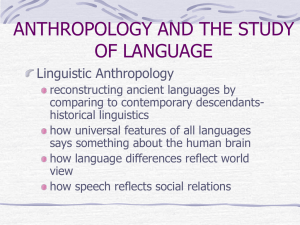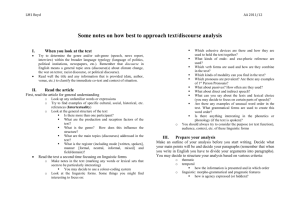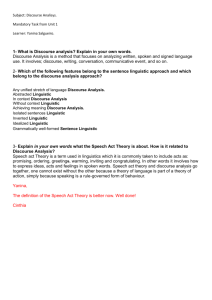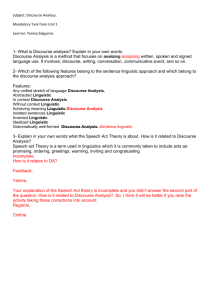language, society, culture
advertisement
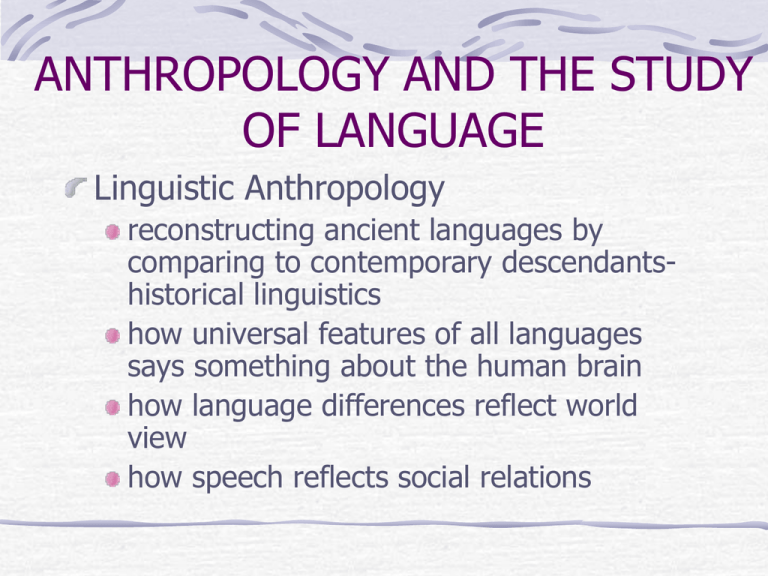
ANTHROPOLOGY AND THE STUDY OF LANGUAGE Linguistic Anthropology reconstructing ancient languages by comparing to contemporary descendantshistorical linguistics how universal features of all languages says something about the human brain how language differences reflect world view how speech reflects social relations Language is a System of Symbols symbols are objects, events, speech sounds, written forms, gestures, which humans attach meaning Symbols operate in changing fields of social relationships symbols are multivocal -- enables a wide range of groups & individuals to relate to the same symbol in a variety of ways LINGUISTIC ANTHROPOLOGY Descriptive Linguistics or FORMAL LINGUISTICS study language as a formal system of rules a set of rules that can be studied apart from its context Historical Linguistics Ethnolinguistics Language in its Social & Cultural Settings • Does language influence the perception of reality and cultural behavior? • Does language reflect reality in a culture? • Or, is it both? LINGUISTIC RELATIVISM and DETERMINISM Edward Sapir/Benjamin Lee Whorf – the “Sapir-Whorf Hypothesis” language & culture intrinsically linked "language is a guide to social reality... it powerfully conditions all our thinking about social problems and processes." Language and Thought Sapir-Whorf hypothesis Language predisposes people to see the world in a certain way guiding behavior Language reflects reality Rich vocabulary reflects a cultural focus GRAMMAR AND CONSCIOUSNESS linguistic conditioning of behavior – “linguistic determinism” language is not simply a way of voicing ideas, but the very thing which shapes those ideas Lexicon and Focal Vocabulary lexicon – a vocabulary; a dictionary of terms focal vocabulary -- specialized set of terms & distinctions that are particularly important to a certain group tell us something about world view, historical events, ideas, influences, perceptions important to a particular group Inuit terms for snow; skiers terms for snow Ethnography of Communication the descriptive study of the use of language, deeply embedded in its cultural and social context (Dell Hymes) The acronym SPEAKING S – setting and scene P – participants E – ends: the desired or expected outcome A – Act: how form and content are delivered K – key: mood or spirit (serious, ironic, etc.) I – instrumentalities: the dialect or language variety N – norms: speaking conventions G – genres: different types of performance (speech, joke, sermon, etc.) Paralinguistic Features Body language and extralinguistic noises At least 90% of emotional information in English is transmitted by “body language” and tone of voice Kinesics System of notating and analyzing postures, facial expressions, and body motions that convey messages Social Dialects Forms of a language Reflecting regions or social classes Similar enough to be mutually intelligible Social dialects (or sociolects) are language varieties that are correlated not so much with geographic as with social space Examples – black English, Spanglish, inner city Boston, Newfie Regional/Geographic Dialects Define people by where they live “southern” dialect “newfie” Language and Gender Linguistic features as markers of social divisions in society North American society Men and Women use English differently • Language reflects traditional gender inequality • Are Women More Polite than Men? N. America Women typically use more polite speech Characterized by a high frequency of honorific and softening devices such as hedges and questions “act like a lady” “respect those around you” Boys and men & the “masculine voice” Languages in Contact Diglossia Bilingualism Pidgins and creoles DIGLOSSIA Speech communities in which two or more varieties of the same language are used by some speakers under different conditions Classic Arabic of the Koran and diversified local forms of Arabic Java – Javanese and Bahasa Indonesia BILINGUALISM “native-like” control of two languages A gradient Degrees or stages of bilingualism based on performance – the ability to understand and produce meaningful utterances in the second language Pidgin Languages a pidgin is a lingua franca that comes into use in situations where a group of individuals with no language in common find a need to communicate a minimal language a mixed language, bulk of vocab usually from the language of the dominant power many pidgins are short-lived Creole Languages a creole – a pidgin that remains in use and is expanded to serve the whole range of functions necessary to a speech community – over the course of two or more generations Reflects hybrid origins SPEECH EVENTS how individuals behave with speech in a specific, culturally defined situation LINGUISTIC CODES AND SPEECH COMMUNITIES Speech communities – a real social unit within which speakers share a repertoire of ‘ways of speaking’ may include one or several languages Members of such communities engage in verbal interaction that is not randomly alternating between distinct LINGUISTIC CODES but choose systematically among them and put them to specialized uses CODE SWITCHING Crystal (1987) suggests that code, or language, switching occurs when an individual who is bilingual alternates between two languages during his/her speech with another bilingual person WHY CODE SWITCH? a speaker may not be able to express him/herself in one language so switches to the other to compensate for the deficiency switching commonly occurs when an individual wishes to express solidarity with a particular social group to create a special effect CODE SWITCHING AS METACOMMUNICATION Code switching is an indirect form of social commentary code switching is a linguistic device for FRAMING verbal messages it is a fine-grained technique for identifying stretches of talk as particular kinds of doings that are intended to accomplish particular kinds of work Language Registers A variety of language that serves a particular social situation Monolingual code switching – styles of speaking The vernacular, the standard, the honorific Specifically defined varieties – scientific, legal, religious, intimate, etc. Language, Nationalism, Ethnicity Linguistic nationalism – attempt by ethnic minorities and even countries to proclaim independence by purging their languages of foreign terms or reviving unused languages Language Planning and Identity Purification Revival Reform Standardization Modernization Discourse, Subjectivity, Power Discourses Ways of talking about the world a system of representation Codes and conventions rules and practices that produced meaningful statements and regulated discourse in different historical periods about language and practice Discourse is "a group of statements which provide a language for talking about ...a particular topic at a particular historical moment." "Discourse, Foucault argues, “constructs the topic. It defines and produces the objects of our knowledge. It governs the way that a topic can be meaningfully talked about and reasoned about.” Discourse, Subjectivity, Power Discourse -- the bearer of various subject positions Subject positions -- specific positions of agency and identity in relation to particular forms of knowledge and practice Subjectivity --produced within discourse, subjected to discourse. subject position--[for us to become the subject of a particular discourse, and thus the bearers of its power/knowledge] we must locate ourselves in the position from which the discourse makes most sense, and thus become its 'subjects' by subjecting' ourselves to its meanings, power and regulation. Discourse, Subjectivity, Power power follows from our casual acceptance of the "reality with which we are presented" Power: a field of possibilities in which several ways of behaving, several reactions and diverse comportments may be realized the totality of practices, by which one can constitute, define, organize, instrumentalize the strategies which individuals in their liberty can have in regard to each other Discourse, Gender, Power sexuality and the body -- sites of power and politics socially imposed structures that objectified sexual identity and gender differences socially imposed structures that shape gender relations and behavior
